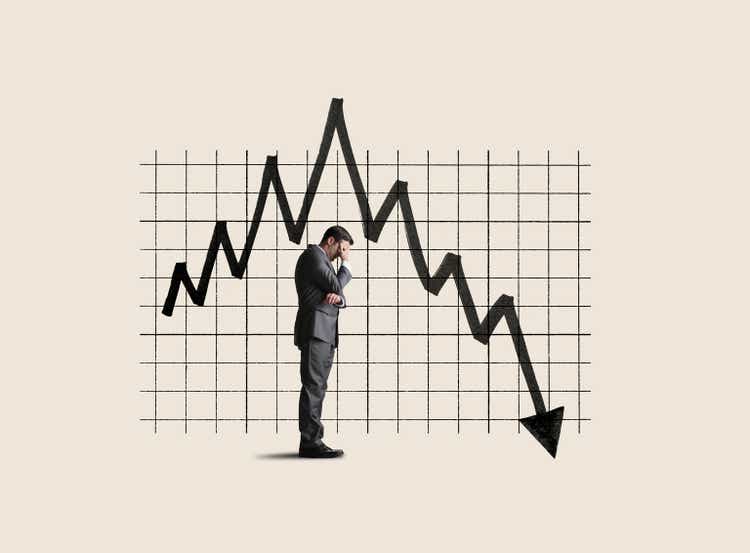
DNY59
Thesis
Whether there is a recession or not, stocks look reasonably valued today and the S&P 500 (NYSEARCA:SPY) should continue to perform well in the long term.
What Is A Recession?
The official definition of a recession has been the topic of much debate lately. Many refer to a recession as two or more consecutive quarters of negative GDP growth, a requirement which was already met in Q1 and Q2 of 2022.
However, others argue that in addition to (or instead of) negative GDP growth, a recession must be characterized by a sustained period of economic decline, with a broad impact reaching areas like trade, manufacturing, and labor. For example, most people consider the period from February-March 2020 a recession, even though it was less than two quarters.
Recessions are temporary, and thus the semantics of a recession are not all that important to long-term investors. But it’s worth noting that there has been a clear correlation between recessions and the labor market, which has not held today.
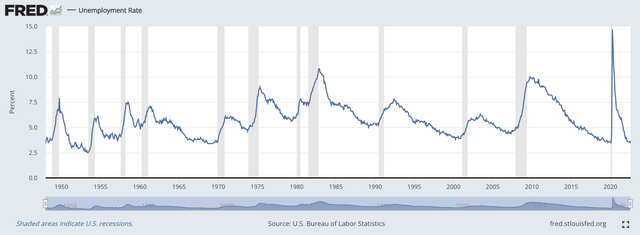
FRED
The shaded areas in the above chart are past recessions, and we can see that each shaded area is accompanied by a steep rise in unemployment. The inverse also holds: each steep rise in unemployment is accompanied by a recession. Since the current labor market has remained strong, at least through August, it’s safe to say that at least one element of a traditional recession is missing.
That doesn’t mean a recession won’t come in short order, as the Fed continues to hike rates and many companies recently lowered or suspended guidance citing macro issues. If we begin seeing massive layoffs, then it’s safe to say that we’re probably entering a recession.
If that does happen, what’s the outlook on the S&P 500? Let’s take a look.
Historical Recessions
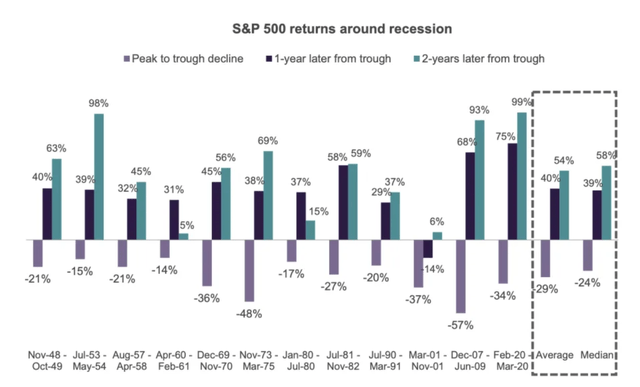
Yahoo Finance
As shown in the above chart from Yahoo Finance, the median peak-to-trough decline of the S&P 500 during a recession is -24%, and because there were a few particularly bad recessions the mean is higher at a -29% decline. The full range of declines goes from -14% to -57%, so there’s quite a range of outcomes here, but it’s clear that investors should expect negative stock market returns surrounding a recession.
This year, SPY peaked at $479.98 and fell to $357.04. That’s a 25.6% decline, meaning that at least by this metric, investors have already priced in a historically average recession.
Considering that the labor market and other signals remain strong, some argue that investors have been too quick to sell stocks and that a rebound is likely on the way. On the other hand, others argue that the current crash started from a record high P/E ratio and that the macro picture looks worse than it has in years, meaning that there’s potentially more room to fall.
I won’t hazard a guess as to who’s right because macro issues are very difficult to predict. However, even for those who are (foolishly) very confident that they know exactly what will happen with the economy, the more important question is what impact will that have on the stock market?
You may think that the chart I shared above answers that question. However, it shows a peak-to-trough decline, which is distinct from the stock market returns during an actual recession because the peak-to-trough decline may start before and/or end after the recession. Here are the market’s returns during the actual months of the recessions in the above chart:
| Recession | SPY Return |
| Nov-48:Oct-49 | 11% |
| Jul-53:May-54 | 25% |
| Aug-57:Apr-58 | -5% |
| Apr-60:Feb-61 | 18% |
| Dec-69:Nov-70 | 3% |
| Nov-73:Mar-75 | -24% |
| Jan-80:Jul-80 | 0% |
| Jul-81:Nov-82 | 6% |
| Jul-90:Mar-91 | 13% |
| Mar-01:Nov-01 | -9% |
| Dec-07:Jun-09 | -39% |
| Feb-20:Mar-20 | -24% |
| Average | -2% |
| Median | 2% |
Source: The Author
The key point here is that markets typically price in a recession before it actually happens and begin to price it out before it’s actually over. With a range of during-recession returns from -39% to +25%, it’s safe to say that whether or not we are currently in a recession has historically had little to no predictable impact on SPY returns. You probably shouldn’t bet on great returns during a recession, but they’re also not out of the question.
Best Course For Investors
At Tech Investing Edge, we invest with a 10+ year time horizon and don’t attempt to time the market based on whether we’re in a recession or other factors. Hopefully, the previous sections have made it clear why that’s my preferred strategy. In this section, I’ll share a few charts about why I think that now is a good time to increase exposure to stocks, through SPY or individual stock picks.
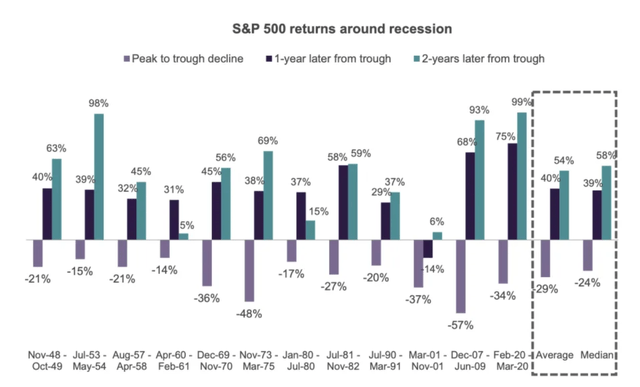
Yahoo Finance
This is the same chart I shared in the previous section. A key point that I didn’t discuss yet is the performance 1 year after the market bottoms, and 2 years after the market bottoms. Investors buying at the market bottom will on average see 40% returns after one year and 54% returns after two years. Those are some of the best returns you’ll ever find with SPY, and it’s again worth noting that the start of those returns will likely happen before the recession is over, if we even get a recession in the first place. Even if investors lump sum into the market now and it continues to sell off with Covid crash extremes (-34%), they’ll on average still be looking at nicely positive returns within the next couple years.
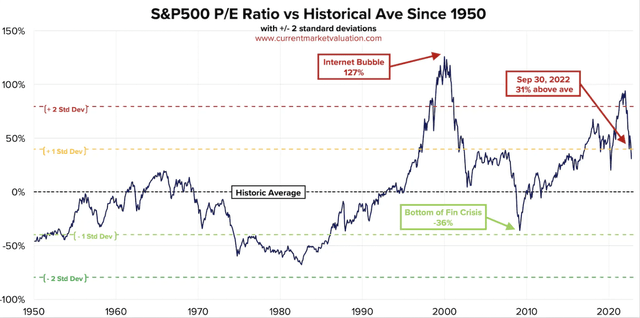
Current Market Valuation
The next data point is the S&P 500’s historical P/E ratio. Today, SPY has a P/E of 18 and a forward P/E ratio of 16. The modern era market average is a P/E of 20, while the average going back to 1870 is 16. Either way, the current P/E ratio is within one standard deviation of the average, meaning that stocks are within a range that would be considered fairly valued based on historical standards. That holds true even if analyst estimates for earnings growth are wrong and we don’t see any earnings growth for the next year.
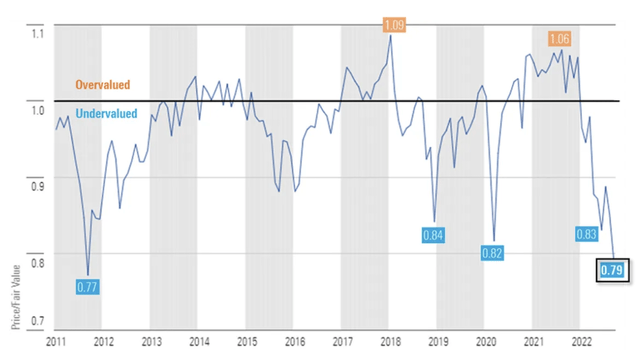
Morningstar Equity Research
Another data point shows the price vs. fair value estimate based on Morningstar’s DCF valuation for the many stocks in their coverage universe. Morningstar is a respected analyst firm. We can see that stocks are currently very undervalued according to their valuation model, in fact more undervalued than they were during the Covid crash or 2018 panic. Investors would have to go back to the 2011 Greece debt crisis in the aftermath of the Great Financial Crisis to find another time when Morningstar thought stocks were as undervalued as they are today. As we all know, stocks have been on an incredible bull run since 2011.
Key assumptions that Morningstar makes include the Fed tightening cycle ending this year and inflation subsiding in 2023. These are somewhat bold assumptions at this point, but there is also the best margin of safety in over a decade if the assumptions prove incorrect.
At my Marketplace service on Seeking Alpha, Tech Investing Edge, I cover a smaller universe of about 30 stocks that I think represent some of the best long-term investing opportunities. My price targets today estimate an average upside of 73%, which is the highest level since I started the service earlier this year. Thus, my own valuation model for the companies I cover aligns well with Morningstar’s.
Conclusion
Stock market bears have had a great time this year, and many will try to tell you with certainty that SPY will continue going lower until the P/E falls to 15, until inflation subsides, until the war in Ukraine is over, until the recession is over, until the Fed pivots, or until a variety of other conditions are met.
I hope that this article provided multiple data points to show that nobody knows for sure what markets will do in the near future, even if you’re of the belief that a recession is inevitable or already happening. Investors should still prepare themselves for more volatility and potentially more negative returns as the market searches for a bottom and digests the currently poor economic environment.
However, risk-tolerant investors should consider increasing their exposure to stocks through SPY or individual stock picks, as the market has bounced back after each past recession and will likely bounce back after this one as well. Often, that bounce comes sooner than many market participants expect.


Be the first to comment